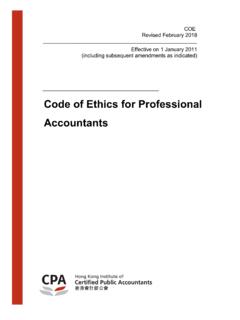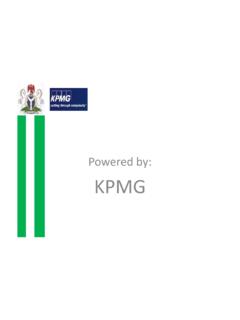Transcription of International Federation of Accountants - oecd.org
1 International Federation of Accountants IPSASB's Conceptual Framework Project: Phase 1 -3: A Brief Introduction Prof. Dr. Andreas Bergmann, Chair 11th OECD Accrual Symposium 04 March 2011, Paris Conceptual Framework goes into major consultation phase Exposure Draft on Phase 1: Role, Authority and Scope; Objectives and Users; Qualitative Characteristics; Reporting Entity Consultation Paper on Phase 2: Elements and Recognition in Financial Statements Consultation Paper on Phase 3: Measurement of Assets and Liabilities in Financial Statements Consultation period for all documents runs to June 15, 2011.
2 Respond to all or some of Specific Matters for Comment Supporting publications At a Glance' summaries for Consultation Papers Staff draft: Key Characteristics of the Public Sector Highlights aspects of public sector environment with potential impact on Conceptual Framework and standard setting To be considered further by IPSASB in March and exposed for comment Role and Authority of Conceptual Framework Establishes concepts that underpin general purpose financial reporting by public sector entities other than GBEs IPSASB to apply concepts in developing IPSASs and non-authoritative guidance Does not establish authoritative requirements or override requirements of current IPSASs Can provide guidance in
3 Dealing with issues not addressed by IPSASs Mismatches between current IPSAS requirements and concepts likely to be addressed, but in accordance with structured plan Will not happen overnight Background (1). Launched in 2006 as collaborative project with NSS. and similar bodies Decision to prioritize in late 2009. Aim to publish completed Framework in 2013. Long-term impact on IPSASB standard setting Background (2). Majority of current IPSASs based on IFRS to extent that requirements of those IFRSs relevant to public sector Guidelines to direct process ( Rules of the Road').
4 IASB currently developing improved Conceptual Framework in project with FASB. Monitoring of IASB developments but not a convergence' project that interprets IASB. Framework Need to consider concepts governing statistical financial reporting models Conceptual Framework: What we are Covering Phase One: Users, Objectives, Scope, Qualitative Characteristics, Reporting Entity Phase Two: Elements & Recognition Phase Three: Measurement Phase Four: Presentation (including Disclosure). Conceptual Framework: Phase 1: Some Key Issues (1). Objectives Accountability and decision-making Primary users Service recipients and resource providers and their representatives (includes citizens but broader).
5 Legislature and legislators primary users in capacity as representatives of service recipients and resource providers Scope Evolve in response to user needs Financial statements at core of financial reporting, but more comprehensive' including, for example: prospective financial information service performance compliance with budget Conceptual Framework: Phase 1: Some Key Issues (2). Qualitative characteristics (QCs). Relevance, faithful representation, understandability, timeliness, comparability, verifiability Constraints on information included oin GPFRs Materiality, Cost-Benefit, Balance between QCs Points to note: Faithful representation' rather than reliability'.
6 No distinction between fundamental and enhancing cxharateritics Materiality as pervasive constraint rather than entity- specific. Conceptual Framework: Phase 1: Some Key Issues (3). Reporting entity IPSASB does not propose what a reporting entity is Importance of identifying users dependent on GPFRs for information Group reporting entity determined by reference to authority and capacity to direct activities of other entity in order to benefit from activities or exposure to financial burden or loss Conceptual Framework: Phase 2: Purpose of Consultation Paper Identify: Elements to be defined Key characteristics of those elements Recognition criteria Examine asset & liability-led and revenues and expenses-led approaches to financial performance Elements and Recognition: A Few Key Issues Does economic benefits' (usually considered part of definition) include service potential'?
7 Are rights and powers of public sector entities, such as power to tax and levy fees, inherent assets or assets only when powers exercised or immediate event? Do liabilities arise from non-exchange transactions only when obligations legally enforceable? Must there be an identifiable past event' for assets and liabilities to exist? Should revenues and expenses be determined by identifying inflows and outflows applicable to a particular period or by changes in net assets in a reporting period? Do ownership interests exist in the public sector? Conceptual Framework: Phase 3: Purpose of Consultation Paper To identify factors that should be considered in choosing measurement bases Examine measurement bases and approaches Presumes mixed measurement model Historical cost Market values Replacement cost Deprival value approach Measurement: A Few Key Issues Should the role of the Framework be to identify factors that are relevant in selecting measurement basis for particular assets and liabilities in specific circumstances, or to specify a single measurement basis or combination of bases?
8 What are the advantages and disadvantages of historical cost, market value and replacement cost? Is deprival value a useful approach to determining a measurement basis? Deprival value for assets Deprival value = lower of Recoverable Replacement amount =. cost higher of Value in use Net realizable value Questions and Discussion Visit our webpage Or contact us by e-mail : Chair IPSASB: Project Coordinator Conceptual Framework.



















